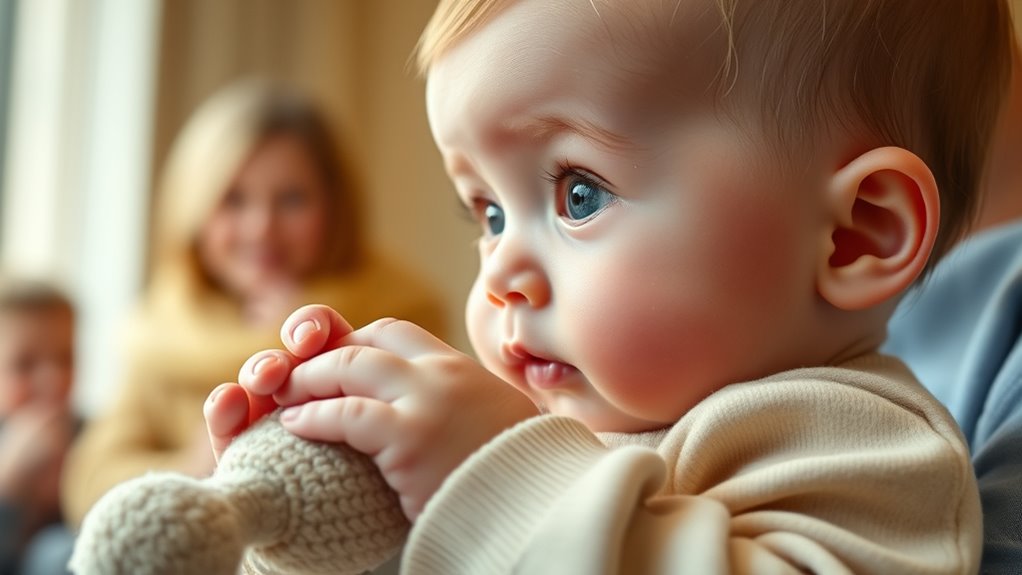At 8 months, your baby’s fears are usually a normal part of growth, not something more serious. They may show stranger anxiety or get upset when separated from you because they’re developing awareness of their environment and forming strong attachments. These behaviors help them trust caregivers and build confidence. If you want to understand how to support them during this stage, there’s more helpful guidance to explore.
Key Takeaways
- Fear of strangers at 8 months is a normal developmental milestone indicating attachment and cognitive growth.
- Separation anxiety and stranger fears often coexist, reflecting your baby’s understanding of object permanence and trust.
- Observe if your baby shows distress only around unfamiliar people; persistent or extreme fears might need further evaluation.
- Support your baby by offering reassurance, gentle introductions, and patience as they gradually build confidence with new faces.
- These fears typically diminish over time; understanding their normalcy helps reduce parental concern and promotes healthy development.

As your 8-month-old explores more of their surroundings, you might notice them showing signs of fear or hesitation. This is a common phase as your baby becomes more aware of the world around them. One of the most noticeable reactions is separation anxiety, where they become distressed when you’re not within sight. This isn’t a sign of bad parenting or a problem; it’s a natural part of their development as they start to understand that they are separate from you. When you leave the room or they’re handed over to someone else, they might cry or cling tightly, seeking comfort and reassurance. This behavior shows they’re forming strong attachments and learning to trust that you’ll return.
At the same time, your baby might also show signs of discomfort during stranger interaction. They could stare nervously at new people, cling to you more tightly, or even cry when approached by someone unfamiliar. This stranger anxiety can be unsettling to witness, but it’s entirely normal at this stage. Your little one is testing boundaries and learning to differentiate between familiar and unfamiliar faces. They rely heavily on your reactions to gauge whether new people are safe or not. If you remain calm and supportive, reassuring them with gentle words and a steady presence, you help them feel more secure. It’s important to give them plenty of opportunities to observe strangers from a safe distance, so they gradually become comfortable with new faces.
You might wonder how to help your baby navigate these fears. The key is patience and consistency. When they’re distressed by separation, try to establish predictable routines, like saying goodbye with a hug and a kiss, so they learn that goodbyes are temporary. When it comes to stranger interaction, avoid forcing your baby to accept new people immediately. Instead, encourage gentle introductions and let your baby approach at their own pace. If they’re clingy, don’t take it personally; instead, give them extra cuddles and reassurance. Over time, your baby will develop confidence and trust, making separation and stranger encounters less alarming. Recognizing these behaviors as part of normal developmental milestones can help you feel more confident in guiding them through this phase.
Frequently Asked Questions
When Should I Be Concerned About My Baby’s Fears?
You might wonder when your baby’s fears become a concern. Typically, separation anxiety and stranger discomfort are normal around 8 months, but if these fears persist beyond a few months or worsen, it’s worth talking to your pediatrician. Watch for signs like intense distress, refusal to be comforted, or developmental delays. Trust your instincts—if your baby’s fears seem excessive or interfere with daily life, seeking guidance is a good step.
How Can I Differentiate Between Normal Fear and Anxiety?
Have you wondered how to tell if your baby’s fears are normal or signaling anxiety? You’re observing their emotional development and sensory sensitivities. Normal fears usually fade quickly and are specific, like fear of loud noises, while anxiety persists longer, intensifies, or interferes with daily activities. If your little one avoids everything or shows excessive distress, it might be more than typical fear. Trust your instincts and consult a professional if needed.
Are There Specific Triggers That Increase Fears at This Age?
You might notice your 8-month-old’s fears spike in unfamiliar environments or during separation from you. New faces or places can trigger separation anxiety, making your baby cling or cry. Familiar routines and gentle reassurance help ease their fears. Be attentive to these triggers, and remember that this stage is normal. With patience and consistent comfort, your little one will gradually become more confident exploring new experiences.
What Activities Can Help Soothe a Scared 8-Month-Old?
You can help soothe your scared 8-month-old through playful interactions that boost their confidence and comfort routines that provide security. Engage in gentle play, like peek-a-boo or singing, to distract and reassure. Consistently sticking to comforting routines, such as cuddling or reading, helps your baby feel safe. These activities create a predictable environment, reducing fears and encouraging trust during uncertain moments.
How Do Fears at This Age Impact Development Long-Term?
Fears at this age can influence your child’s emotional resilience and social confidence down the line. If you support them through their worries with patience and reassurance, they learn to manage emotions better, building resilience. Overcoming small fears helps develop trust and social skills, setting a foundation for healthy relationships. So, your gentle guidance now plays an essential role in shaping their long-term emotional well-being and confidence in social settings.
Conclusion
Remember, every baby’s fears are a sign they’re growing and learning. While stranger anxiety is common, it’s also a chance to build trust and security. Be patient, gentle, and consistent, knowing that “a journey of a thousand miles begins with a single step.” Your support helps your little one feel safe as they navigate new feelings. With love and understanding, you’re guiding them through this important stage of development.










